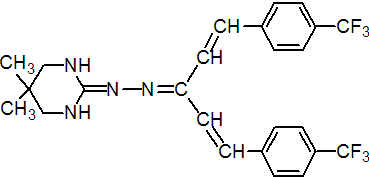|
hydramethylnon
Insecticide
IRAC 20

NOMENCLATURE
Common name: hydramethylnon (BSI, ANSI, draft E-ISO); hydraméthylnone ((f) draft F-ISO)
IUPAC name: 5,5-dimethylperhydropyrimidin-2-one 4-trifluoromethyl-a-(4-trifluoromethylstyryl)cinnamylidenehydrazone
Chemical Abstracts name: tetrahydro-5,5-dimethyl-2(1H)-pyrimidinone [3-[4-(trifluoromethyl)phenyl]-1-[2-[4-(trifluoromethyl)phenyl]ethenyl]-2-propenylidene]hydrazone
CAS RN: [67485-29-4]
Development codes: AC 217 300; CL 217 300 (both Cyanamid)
PHYSICAL CHEMISTRY
Composition: Tech. grade is ³95% pure.
Mol. wt.: 494.5
M.f.: C25H24F6N4
Form: Yellow to tan crystals.
M.p.: 189-191 °C
V.p.: <0.0027 mPa (25 ºC); a value of <0.0008 mPa (45 ºC) has also been reported
KOW: logP = 2.31
Henry: 7.81 ´ 10-1 Pa m3 mol-1 (25 °C, calc.)
S.g./density: 0.299 (25 °C)
Solubility: In water 0.005-0.007 mg/l (25 ºC). In acetone 360, ethanol 72, 1,2-dichloroethane 170, methanol 230, isopropanol 12, xylene 94, chlorobenzene 390 (all in g/l, 20 ºC).
Stability: When stored in original unopened container, stable in excess of 24 mo at 25 ºC, 12 mo at 37 ºC, and 3 mo at 45 ºC. Undergoes photolysis in sunlight (DT50 c. 1 h). DT50 in aqueous suspension (25 ºC) 24-33 d (pH 4.9), 10-11 d (pH 7.03), 11-12 d (pH 8.87).
COMMERCIALISATION
History: Insecticide reported by J. B. Lovell (Proc. Br. Crop Prot. Conf. - Pests Dis., 1979, 2, 575). Introduced by American Cyanamid Co. (now BASF AG) and first marketed in 1980.
Patents: US 4163102, US 4213988
Manufacturers: BASF
APPLICATIONS
Biochemistry: Site II electron transport inhibitor. Inhibits cellular respiration.
Mode of action: Non-systemic insecticide with stomach action.
Uses: Selective control of agricultural and household Formicidae (especially Camponotus, Iridomyrmex, Monomorium, Solenopsis and Pogonomyrmex spp. and Pheidole megacephala), Blattellidae (especially Blatta, Blattella, Periplaneta and Supella spp.), Kalotermitidae (especially Incisitermes) and Rhinotermitidae (especially Reticulitermes, Coptotermes, Heterotermes) using baits. Due to slow action, can be carried into nest by worker ants and kill the queen. Used at c. 16 g/ha per application.
Phytotoxicity: No phytotoxicity observed.
Formulation types: PA; RB.
Selected products: 'Siege' (ants and cockroaches) (BASF); 'Subterfuge' (termites) (BASF); 'Combat' (ants and cockroaches) (Clorox)
OTHER PRODUCTS
'Amdro' (ants and cockroaches) (BASF); 'Maxforce' (ants and cockroaches) (Johnson)
Discontinued products: 'Wipeout' * (Cyanamid)
ANALYSIS
Product analysis by glc.
MAMMALIAN TOXICOLOGY
Oral: Acute oral LD50 for male rats 1131, female rats 1300 mg/kg.
Skin and eye: Acute percutaneous LD50 for rabbits >5000 mg/kg. Not a skin irritant to rabbits or guinea pigs; reversible irritant to eyes of rabbits. No skin sensitisation (guinea pigs).
Inhalation: LC50 (4 h) for rats >5 mg/l air (aerosol or dust).
NOEL: (28 d) for rats 75 mg/kg diet; (90 d) for rats 50 mg/kg diet; (2 y) for rats 50 mg/kg diet; (18 mo) for mice 25 mg/kg diet; (90 d) for beagles 3.0 mg/kg daily; (6 mo) for beagles 3.0 mg/kg daily.
Other: Non-teratogenic and non-embryotoxic in rats and rabbits. Non-mutagenic.
Toxicity class: WHO (a.i.) III; EPA (formulation) III
ECOTOXICOLOGY
Birds: Acute oral LD50 for mallard ducks >2510, bobwhite quail 1828 mg/kg.
Fish: Toxic under laboratory conditions using a solvent, but very little risk to fish is expected under normal field conditions because of the compound's low solubility in water and rapid degradation in sunshine. LC50 (96 h) for bluegill sunfish 1.70, rainbow trout 0.16, channel catfish 0.10 mg/l; for carp 0.67, 0.39, and 0.34 mg/l (24, 48, and 72 h, respectively).
Daphnia: LC50 (48 h) 1.14 mg/l; little hazard would be expected under field conditions because of the very low solubility in water.
Bees: Dust is non-toxic topically to honeybees at 0.03 mg/bee.
ENVIRONMENTAL FATE
Animals: In rats, following oral administration, rapidly eliminated in the faeces and urine. No residues were detectable in the milk or tissues of goats (0.2 mg/kg in the daily diet for 8 days). No residues were found in the milk or tissues of cows (0.05 mg/kg for 21 consecutive days).
Plants: Residues in grass 4 months after treatment were <0.01 ppm. Negligible residues were found in radishes, barley, and french beans planted 3 months after treatment of the soil.
Soil/Environment: Rapidly degraded in sunlight by photolysis (DT50 <1 h). Half-life in sandy loam is c. 7 d; half-life when incorporated in sandy loam is c. 28 d. Formulated bait decomposes rapidly in daylight. Not mobile and does not leach. Low bioaccumulation potential.
|